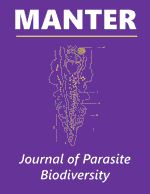Parasitology, Harold W. Manter Laboratory of
ORCID IDs
D.E. Peterson https://orcid.org/0000-0003-0870-3803
Date of this Version
4-3-2023
Document Type
Article
Citation
MANTER: Journal of Parasite Biodiversity (ISSN 2470-8224) Occasional Papers, Number 31, April 10, 2023
doi: 10.32873/unl.dc.manter31
Abstract
The geographical ranges of many mammals and their associated parasites are dynamic. Comprehensive documentation of these communities over time provides a foundation for interpreting how changing environmental conditions, driven by accelerating climate change, other anthropogenic disturbances, and natural events, may influence host-parasite interactions. Fleas (Order Siphonaptera) are obligate, hematophagous parasites of birds and mammals with medical interest because of their role in transmitting pathogens. From 2016 to 2019, we sampled the small mammal and associated flea communities in El Malpais National Conservation Area (El Malpais) in Cibola County, New Mexico. Among 898 mammalian specimens, 925 fleas representing 29 species were collected from 18 host species. Pleochaetis exilis was the most abundant flea species, composing 27% of the total fleas collected, whereas Aetheca wagneri was the most prevalent flea species, parasitizing 8% of the community sampled. Across a total of 284 hosts recorded with fleas, A. wagneri, Malaraeus eremicus, and Peromyscopsylla hesperomys adelpha parasitized the most host species (n = 6 each). Onychomys leucogaster (Wied-Neuwied, 1841), the northern grasshopper mouse, a rodent highly implicated in plague dynamics, was host for the highest number of flea species (n = 15), followed by Peromyscus truei (Shufeldt, 1885) (n = 10). Our aims are to (a) describe the flea-mammal assemblage of a central New Mexico site, creating a baseline for diversity against which changing patterns of association can be assessed over time; (b) identify previously unrecognized host associations; and (c) examine infestation parameters, including the relationships of flea prevalence and mean abundance to host sex, host abundance, and seasonality. As such, our study exemplifies the Documentation and Assessment phases of the DAMA protocol (Document, Assess, Monitor, Act), a central component of exploring distribution and diversity of complex pathogen-host communities across space and time that are essential to a proactive understanding of emerging disease.


Comments
Copyright © 2023 D.E. Peterson, J.L. Dunnum, S.W. Liphardt, K.A. Boegler, R.P. Eckerlin, E.P. Hoberg, M.O. Perez-Arriaga, K. Derieg, D. Garnand, M.L. Campbell, and J.A. Cook